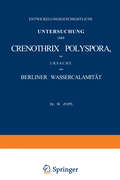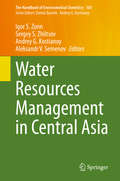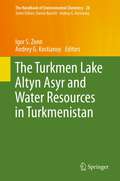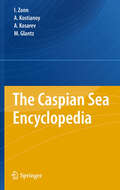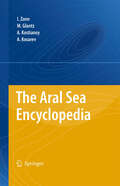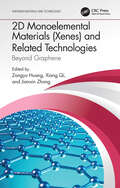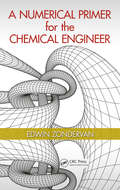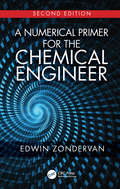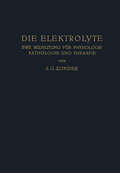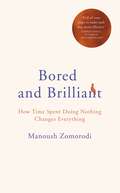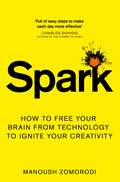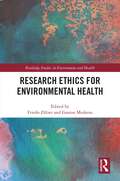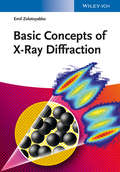- Table View
- List View
Pfortader-Leberkreislauf, Stoffwechsel und Kollaps
by Gustav ZopffDieser Buchtitel ist Teil des Digitalisierungsprojekts Springer Book Archives mit Publikationen, die seit den Anfängen des Verlags von 1842 erschienen sind. Der Verlag stellt mit diesem Archiv Quellen für die historische wie auch die disziplingeschichtliche Forschung zur Verfügung, die jeweils im historischen Kontext betrachtet werden müssen. Dieser Titel erschien in der Zeit vor 1945 und wird daher in seiner zeittypischen politisch-ideologischen Ausrichtung vom Verlag nicht beworben.
Entwickelungsgeschichtliche Untersuchung über Crenothrix Polyspora, die Ursache der Berliner Wassercalamität
by W. ZopfWater Resources Management in Central Asia (The Handbook of Environmental Chemistry #105)
by Igor S. Zonn Sergey S. Zhiltsov Andrey G. Kostianoy Aleksandr V. SemenovThis book reviews the current status of water resources management in Central Asian countries, and outlines the history, policies and cross-border cooperation regarding water resources management in the region. Particular attention is paid to the evolution of water resources management in Central Asia, past and future water transfer projects, specific problems concerning water use and pollution, and national approaches to water management in Kazakhstan, Kyrgyzstan and Tajikistan, as well as to related conflicts between the Central Asian countries. Together with the companion volumes on Water Resources in Central Asia: International Context and Water Bodies and Climate Change in Central Asia, it offers a valuable source of information for a broad readership, from students and scientists interested in the environmental sciences, to policymakers and practitioners working in the fields of water resources policy and management, international relations, and environmental issues.
The Turkmen Lake Altyn Asyr and Water Resources in Turkmenistan (The Handbook of Environmental Chemistry #28)
by Igor S. Zonn Andrey G. KostianoyThis book offers a concise description of the environment and water resources in Turkmenistan. The focus is on the water bodies of Turkmenistan – the Caspian Sea, Kara-Bogaz-Gol Bay, Sarykamysh Lake, Amu Darya River, and the Karakum Canal. Respected experts from six different countries cover the landscape-geographical features, the Karakum Desert, biodiversity (especially of birds and fishes) and ecosystems, as well as regional climate change. Special attention is paid to the Altyn Asyr Lake water reclamation project, to the morphometric characteristics of the Karashor Depression, and to the four-year-long satellite monitoring of the construction area in the vicinity of the Karashor Depression. The information presented is based on observational data and scientific literature, mainly published in Russian. This is the first English book on the Altyn Asyr Project. It addresses specialists working in various fields of environmental problems and ecology, water resources and management, land reclamation and agriculture, regional climate change, and international cooperation in the water sector in Turkmenistan and Central Asia.
The Caspian Sea Encyclopedia (Encyclopedia of Seas)
by Igor S. Zonn Aleksey N Kosarev Michael Glantz Andrey G. Kostianoy“The Caspian Sea Encyclopedia” is the second one in the new series of encyclo- dias about the seas of the former Soviet Union published by Springer-Verlag. The ?rst volume – “The Aral Sea Encyclopedia” was published by Springer in 2009. The series will be continued by “The Black Sea Encyclopedia” in 2010. Today the Caspian Sea is known to readers thanks to its oil and gas resources, sturgeon and caviar, signi?cant sea-level variations, socio-economic and political problems. The Caucasus and Central Asia (http://eurodialogue. org/?les/fckeditor_?les/Caspian-s- map2. png) vii viii Introduction For more than 250 years the Caspian Sea was shared by two states: Russia (the Soviet Union) and Persia (Iran). After the disintegration of the USSR in 1992, the new independent states of Azerbaijan, Turkmenistan and Kazakhstan have radically changed the political and economic situation in the region. In addition to Russia and Iran, who had determined the situation on the Caspian for a long period, Azerbaijan, Turkmenistan and Kazakhstan are now interested parties, beginning a new stage in the historical development of the Caspian region. This increase in the number of the Caspian legal entities from two to ?ve has given rise to a whole tangle of geopolitical, economic, international legal, ethnic and environmental problems, each of which demands its own approach and settlement mechanism.
The Aral Sea Encyclopedia (Encyclopedia of Seas)
by Igor S. Zonn M. Glantz Aleksey N. Kosarev Andrey G. KostianoyThe ‘‘Aral Sea Encyclopedia’’ is the first one in the new series of encyclopedias about the seas of the former Soviet Union. Preparing it we faced certain difficulties. The thing is that this encyclopedia is a monument to the sea that is disappearing during our lifetime. The world community considers the situation with the Aral Sea and all changes that occurred in its whereabouts in the recent decades as one of the most serious, if not disastrous anthropogenic environmental crises of the 20th century. Before 1960, this was a water-abundant sea-lake that was fourth among world lakes after the Caspian Sea (USSR, Iran), the Great Lakes (USA, Canada) and Victoria Lake (Africa). This was a real ‘‘pearl’’ among the sands of the largest deserts, the Karakums and the Kyzylkums. Navigation between the sea ports Muinak and Aralsk and fisheries famous for the Aral breams, barbells, sturgeons, shemaya, and others were developed here. One could find beautiful recreational zones and beaches here. The deltas of the Amudarya, the major river of Central Asia, and the Syrdarya bringing their waters into the Aral Sea were famous for their biodiversity, fishery, muskrat rearing, reed prod- tion. The local population found occupations related to the water infrastructure.
2D Monoelemental Materials: Beyond Graphene (Emerging Materials and Technologies)
by Zongyu Huang, Xiang Qi, and Jianxin ZhongMonoelemental 2D materials called Xenes have a graphene-like structure, intra-layer covalent bond, and weak van der Waals forces between layers. Materials composed of different groups of elements have different structures and rich properties, making Xenes materials a potential candidate for the next generation of 2D materials. 2D Monoelemental Materials (Xenes) and Related Technologies: Beyond Graphene describes the structure, properties, and applications of Xenes by classification and section. The first section covers the structure and classification of single-element 2D materials, according to the different main groups of monoelemental materials of different components and includes the properties and applications with detailed description. The second section discusses the structure, properties, and applications of advanced 2D Xenes materials, which are composed of heterogeneous structures, produced by defects, and regulated by the field. Features include: Systematically detailed single element materials according to the main groups of the constituent elements Classification of the most effective and widely studied 2D Xenes materials Expounding upon changes in properties and improvements in applications by different regulation mechanisms Discussion of the significance of 2D single-element materials where structural characteristics are closely combined with different preparation methods and the relevant theoretical properties complement each other with practical applications Aimed at researchers and advanced students in materials science and engineering, this book offers a broad view of current knowledge in the emerging and promising field of 2D monoelemental materials.
Applications of MALDI-TOF Spectroscopy (Topics in Current Chemistry #331)
by Zongwei Cai and Shuying LiuMALDI-ToF Mass Spectrometry for Studying Noncovalent Complexes of Biomolecules, by Stefanie Mädler, Elisabetta Boeri Erba, Renato Zenobi Application of MALDI-TOF-Mass Spectrometry to Proteome Analysis Using Stain-Free Gel Electrophoresis, by Iuliana Susnea, Bogdan Bernevic, Michael Wicke, Li Ma, Shuying Liu, Karl Schellander, Michael Przybylski MALDI Mass Spectrometry for Nucleic Acid Analysis, by Xiang Gao, Boon-Huan Tan, Richard J. Sugrue, Kai Tang Determination of Peptide and Protein Disulfide Linkages by MALDI Mass Spectrometry, by Hongmei Yang, Ning Liu, Shuying Liu MALDI In-Source Decay, from Sequencing to Imaging, by Delphine Debois, Nicolas Smargiasso, Kevin Demeure, Daiki Asakawa, Tyler A. Zimmerman, Loïc Quinton, Edwin De Pauw Advances of MALDI-TOF MS in the Analysis of Traditional Chinese Medicines, by Minghua Lu, Zongwei Cai Chemical and Biochemical Applications of MALDI TOF-MS Based on Analyzing the Small Organic Compounds, by Haoyang Wang, Zhixiong Zhao, Yinlong Guo Bioinformatic Analysis of Data Generated from MALDI Mass Spectrometry for Biomarker Discovery, by Zengyou He, Robert Z. Qi, Weichuan Yu
Emergent States in Photoinduced Charge-Density-Wave Transitions (Springer Theses)
by Alfred ZongThis book advances understanding of light-induced phase transitions and nonequilibrium orders that occur in a broken-symmetry system. Upon excitation with an intense laser pulse, materials can undergo a nonthermal transition through pathways different from those in equilibrium. The mechanism underlying these photoinduced phase transitions has long been researched, but many details in this ultrafast, non-adiabatic regime still remain to be clarified. The work in this book reveals new insights into this phenomena via investigation of photoinduced melting and recovery of charge density waves (CDWs). Using several time-resolved diffraction and spectroscopic techniques, the author shows that the light-induced melting of a CDW is characterized by dynamical slowing-down, while the restoration of the symmetry-breaking order features two distinct timescales: A fast recovery of the CDW amplitude is followed by a slower re-establishment of phase coherence, the latter of which is dictated by the presence of topological defects in the CDW. Furthermore, after the suppression of the original CDW by photoexcitation, a different, competing CDW transiently emerges, illustrating how a hidden order in equilibrium can be unleashed by a laser pulse. These insights into CDW systems may be carried over to other broken-symmetry states, such as superconductivity and magnetic ordering, bringing us one step closer towards manipulating phases of matter using a laser pulse.
A Numerical Primer for the Chemical Engineer
by Edwin ZondervanSolve Developed Models in a Numerical FashionDesigned as an introduction to numerical methods for students, A Numerical Primer for the Chemical Engineer explores the role of models in chemical engineering. Combining mathematical correctness (model verification) with numerical performance (model validation), this text concentrates on numerical metho
A Numerical Primer for the Chemical Engineer, Second Edition
by Edwin ZondervanDesigned as an introduction to numerical methods for students, this book combines mathematical correctness with numerical performance, and concentrates on numerical methods and problem solving. It applies actual numerical solution strategies to formulated process models to help identify and solve chemical engineering problems. Second edition comes with additional chapter on numerical integration and section on boundary value problems in the relevant chapter. Additional material on general modelling principles, mass/energy balances and separate section on DAE’s is also included. Case study section has been extended with additional examples.
A Numerical Primer for the Chemical Engineer, Second Edition
by Edwin ZondervanDesigned as an introduction to numerical methods for students, this book combines mathematical correctness with numerical performance, and concentrates on numerical methods and problem solving. It applies actual numerical solution strategies to formulated process models to help identify and solve chemical engineering problems. Second edition comes with additional chapter on numerical integration and section on boundary value problems in the relevant chapter. Additional material on general modelling principles, mass/energy balances and separate section on DAE’s is also included. Case study section has been extended with additional examples.
Die Elektrolyte: Ihre Bedeutung für Physiologie Pathologie und Therapie
by S. G. ZondekDieser Buchtitel ist Teil des Digitalisierungsprojekts Springer Book Archives mit Publikationen, die seit den Anfängen des Verlags von 1842 erschienen sind. Der Verlag stellt mit diesem Archiv Quellen für die historische wie auch die disziplingeschichtliche Forschung zur Verfügung, die jeweils im historischen Kontext betrachtet werden müssen. Dieser Titel erschien in der Zeit vor 1945 und wird daher in seiner zeittypischen politisch-ideologischen Ausrichtung vom Verlag nicht beworben.
Bored and Brilliant: How Time Spent Doing Nothing Changes Everything
by Manoush Zomorodi'Bored and Brilliant is full of easy steps to make each day more effective' Charles Duhigg, author of The Power of HabitIt’s time to move ‘doing nothing’ to the top of your to-do list Have you ever noticed how you have your best ideas when doing the dishes or staring out the window? It's because when your body goes on autopilot, your brain gets busy connecting ideas and solving problems.However in the modern world it often feels as though we have completely removed boredom from our lives; we are addicted to our phones, we reply to our emails twenty-four hours a day, tweet as we watch TV, watch TV as we commute, check Facebook as we walk and Instagram while we eat. Constant stimulation has become our default mode. In this easy to follow, practical book, award-winning journalist Manoush Zomorodi explores the connection between boredom and original thinking, and will show you how to ditch your screens and start embracing time spent doing nothing. Bored and Brilliant will help you unlock the way to becoming your most productive and creative self.
Spark: How to free your brain from technology to ignite your creativity
by Manoush Zomorodi'Crammed with practical exercises for anyone who wants to reclaim the power of spacing out' - Gretchen Rubin, author of #1 New York Times Bestseller The Happiness ProjectIt’s time to move ‘doing nothing’ to the top of your to-do list Have you ever noticed how you have your best ideas when doing the dishes or staring out the window? It's because when your body goes on autopilot, your brain gets busy connecting ideas and solving problems.However in the modern world it often feels as though we have completely removed boredom from our lives; we are addicted to our phones, we reply to our emails twenty-four hours a day, tweet as we watch TV, watch TV as we commute, check Facebook as we walk and Instagram while we eat. Constant stimulation has become our default mode. In this easy to follow, practical book, award-winning journalist Manoush Zomorodi explores the connection between boredom and original thinking, and will show you how to ditch your screens and start embracing time spent doing nothing. Spark will help you unlock the way to becoming your most productive and creative self.'Full of easy steps to make each day more effective' Charles Duhigg, author of The Power of Habit*Spark was previously published as Bored and Brilliant.*
Reducing Disaster: Early Warning Systems For Climate Change
by Zinta Zommers Ashbindu SinghAround the world, extreme weather events are becoming increasingly "the new normal" and are expected to increase in the 21st century as a result of climate change. Extreme weather events have devastating impacts on human lives and national economies. This book examines ways to protect people from hazards using early warning systems, and includes contributions from experts from four different continents representing 14 different universities, 8 government agencies and two UN agencies. Chapters detail critical components of early warning systems, ways to identify vulnerable communities, predict hazards and deliver information. Unique satellite images illustrate the transnational impact of disasters, while case studies provide detailed examples of warning systems. With contributors from the fields of economics, ethics, meteorology, geography and biology, this book is essential reading for anyone interested in disaster risk reduction or climate change.
Ethics for Radiation Protection in Medicine (Series in Medical Physics and Biomedical Engineering)
by Friedo Zölzer Gaston Meskens Jim Malone Christina SkourouThis book presents an up to date ethical framework for radiological protection in medicine. It is consistent with the requirements of the system of radiation protection and with the expectations of medical ethics. It presents an approach rooted in the medical tradition, and alert to contemporary social expectations. It provides readers with a practical framework against which they can assess the safety and acceptability of medical procedures, including patients’ concerns. It will be an invaluable reference for radiologists, radiation oncologists, regulators, medical physicists, technologists, other practitioners, as well as academics, researchers and students of radiation protection in medicine. Features: An authoritative and accessible guide, authored by a team who have contributed to defining the area internationally Includes numerous practical examples/clinical scenarios that illustrate the approach, presenting a pragmatic approach, rather than dwelling on philosophical theories Informed by the latest developments in the thinking of international organizations
Ethics for Radiation Protection in Medicine (Series in Medical Physics and Biomedical Engineering)
by Friedo Zölzer Gaston Meskens Jim Malone Christina SkourouThis book presents an up to date ethical framework for radiological protection in medicine. It is consistent with the requirements of the system of radiation protection and with the expectations of medical ethics. It presents an approach rooted in the medical tradition, and alert to contemporary social expectations. It provides readers with a practical framework against which they can assess the safety and acceptability of medical procedures, including patients’ concerns. It will be an invaluable reference for radiologists, radiation oncologists, regulators, medical physicists, technologists, other practitioners, as well as academics, researchers and students of radiation protection in medicine. Features: An authoritative and accessible guide, authored by a team who have contributed to defining the area internationally Includes numerous practical examples/clinical scenarios that illustrate the approach, presenting a pragmatic approach, rather than dwelling on philosophical theories Informed by the latest developments in the thinking of international organizations
Research Ethics for Environmental Health (Routledge Studies in Environment and Health)
by Friedo Zölzer Gaston MeskensResearch Ethics for Environmental Health explores the ethical basis of environmental health research and related aspects of risk assessment and control. Environmental health encompasses the assessment and control of those environmental factors that can potentially affect human health, such as radiation, toxic chemicals and other hazardous agents. It is often assumed that the assessment part is just a matter of scientific research, and that control is a matter of implementing standards that unambiguously follow from that research. But it is less commonly understood that environmental health also requires addressing questions of an ethical nature. Coming from multiple disciplines and nine different countries, the contributors to this book critically examine a diverse range of ethical concerns in modern environmental health research. This book will be of great interest to scholars and practitioners of environmental health, as well as researchers in applied ethics, environmental ethics, medical ethics, bioethics and those concerned with chemical and radiation protection.
Research Ethics for Environmental Health (Routledge Studies in Environment and Health)
by Friedo ZölzerResearch Ethics for Environmental Health explores the ethical basis of environmental health research and related aspects of risk assessment and control. Environmental health encompasses the assessment and control of those environmental factors that can potentially affect human health, such as radiation, toxic chemicals and other hazardous agents. It is often assumed that the assessment part is just a matter of scientific research, and that control is a matter of implementing standards that unambiguously follow from that research. But it is less commonly understood that environmental health also requires addressing questions of an ethical nature. Coming from multiple disciplines and nine different countries, the contributors to this book critically examine a diverse range of ethical concerns in modern environmental health research. This book will be of great interest to scholars and practitioners of environmental health, as well as researchers in applied ethics, environmental ethics, medical ethics, bioethics and those concerned with chemical and radiation protection.
Basic Concepts of X-Ray Diffraction
by Emil ZolotoyabkoAuthored by a university professor deeply involved in X-ray diffraction-related research, this textbook is based on his lectures given to graduate students for more than 20 years. It adopts a well-balanced approach, describing basic concepts and experimental techniques, which make X-ray diffraction an unsurpassed method for studying the structure of materials. Both dynamical and kinematic X-ray diffraction is considered from a unified viewpoint, in which the dynamical diffraction in single-scattering approximation serves as a bridge between these two parts. The text emphasizes the fundamental laws that govern the interaction of X-rays with matter, but also covers in detail classical and modern applications, e.g., line broadening, texture and strain/stress analyses, X-ray mapping in reciprocal space, high-resolution X-ray diffraction in the spatial and wave vector domains, X-ray focusing, inelastic and time-resolved X-ray scattering. This unique scope, in combination with otherwise hard-to-find information on analytic expressions for simulating X-ray diffraction profiles in thin-film heterostructures, X-ray interaction with phonons, coherent scattering of Mössbauer radiation, and energy-variable X-ray diffraction, makes the book indispensable for any serious user of X-ray diffraction techniques. Compact and self-contained, this textbook is suitable for students taking X-ray diffraction courses towards specialization in materials science, physics, chemistry, or biology. Numerous clear-cut illustrations, an easy-to-read style of writing, as well as rather short, easily digestible chapters all facilitate comprehension.
Basic Concepts of X-Ray Diffraction
by Emil ZolotoyabkoAuthored by a university professor deeply involved in X-ray diffraction-related research, this textbook is based on his lectures given to graduate students for more than 20 years. It adopts a well-balanced approach, describing basic concepts and experimental techniques, which make X-ray diffraction an unsurpassed method for studying the structure of materials. Both dynamical and kinematic X-ray diffraction is considered from a unified viewpoint, in which the dynamical diffraction in single-scattering approximation serves as a bridge between these two parts. The text emphasizes the fundamental laws that govern the interaction of X-rays with matter, but also covers in detail classical and modern applications, e.g., line broadening, texture and strain/stress analyses, X-ray mapping in reciprocal space, high-resolution X-ray diffraction in the spatial and wave vector domains, X-ray focusing, inelastic and time-resolved X-ray scattering. This unique scope, in combination with otherwise hard-to-find information on analytic expressions for simulating X-ray diffraction profiles in thin-film heterostructures, X-ray interaction with phonons, coherent scattering of Mössbauer radiation, and energy-variable X-ray diffraction, makes the book indispensable for any serious user of X-ray diffraction techniques. Compact and self-contained, this textbook is suitable for students taking X-ray diffraction courses towards specialization in materials science, physics, chemistry, or biology. Numerous clear-cut illustrations, an easy-to-read style of writing, as well as rather short, easily digestible chapters all facilitate comprehension.
Introduction to Solid State Physics for Materials Engineers
by Emil ZolotoyabkoA concise, accessible, and up-to-date introduction to solid state physics Solid state physics is the foundation of many of today’s technologies, including transistors, LEDs, optoelectronics, and communications. Introduction to Solid State Physics for Materials Engineers offers a guide to basic concepts and provides an accessible framework for understanding this highly application-relevant subject for materials engineers. The text links the fundamentals of modern materials, such as graphene and photonic materials, and of applications, such as high-temperature superconductors and MOSFETs. Written by a noted expert and experienced instructor, the book contains numerous worked examples throughout to help the reader gain a thorough understanding of the concepts and information presented. The text covers a wide range of relevant topics, including electron waves in crystals, electrical conductivity in semiconductors, light interaction with metals and dielectrics, light interaction with semiconductors, cooperative phenomena in electron systems, cooperative phenomena in electron systems, ferroelectricity as a cooperative phenomenon, and more. This important book: Provides a big picture view of solid state physics Contains examples of basic concepts and applications Offers a highly accessible text that fosters real understanding Presents a wealth of helpful worked examples Written for students of materials science, engineering, and physics, Introduction to Solid State Physics for Materials Engineers is an important guide to help foster an understanding of solid state physics.
Introduction to Solid State Physics for Materials Engineers
by Emil ZolotoyabkoA concise, accessible, and up-to-date introduction to solid state physics Solid state physics is the foundation of many of today’s technologies, including transistors, LEDs, optoelectronics, and communications. Introduction to Solid State Physics for Materials Engineers offers a guide to basic concepts and provides an accessible framework for understanding this highly application-relevant subject for materials engineers. The text links the fundamentals of modern materials, such as graphene and photonic materials, and of applications, such as high-temperature superconductors and MOSFETs. Written by a noted expert and experienced instructor, the book contains numerous worked examples throughout to help the reader gain a thorough understanding of the concepts and information presented. The text covers a wide range of relevant topics, including electron waves in crystals, electrical conductivity in semiconductors, light interaction with metals and dielectrics, light interaction with semiconductors, cooperative phenomena in electron systems, cooperative phenomena in electron systems, ferroelectricity as a cooperative phenomenon, and more. This important book: Provides a big picture view of solid state physics Contains examples of basic concepts and applications Offers a highly accessible text that fosters real understanding Presents a wealth of helpful worked examples Written for students of materials science, engineering, and physics, Introduction to Solid State Physics for Materials Engineers is an important guide to help foster an understanding of solid state physics.

